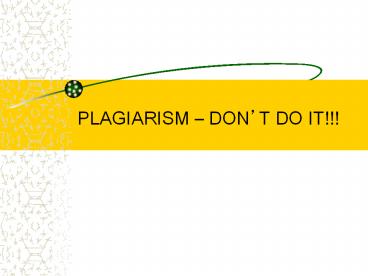PLAGIARISM - PowerPoint PPT Presentation
1 / 20
Title: PLAGIARISM
1
PLAGIARISM DONT DO IT!!!
2
Plagiarism What is it?
- Share as many examples of plagiarismas you can
think of.
3
Plagiarismwhat is it?
- Based on the examples you brainstormed, what is
your definition of plagiarism?
4
- According to Webster, plagiarism is the act of
using another person's words or ideas without
giving credit to that person the act of
plagiarizing something. In other words, it is
cheating or deception.
5
- If you attempt to use another person's work as if
it were your own, without adequate
acknowledgement of the original source and if
this is done in work that you submit for a grade
then you are attempting to deceive your teacher,
your parents, or anyone reading the paper. In
other words, plagiarism is cheating and it is
deceitful in that you are trying to claim the
credit for something that is not your work.
6
Why is plagiarism wrong?
- If you plagiarize, you are cheating yourself.
You don't learn to write out your thoughts in
your own words, and you don't get specific
feedback geared to your individual needs and
skills. Plagiarism is dishonest because it
misrepresents the work of another as your own. - Unintentional plagiarism is still cheating.
7
Guidelines for avoiding plagiarism
- Use your own words and ideas.
- Give credit for copied, adapted, or paraphrased
material. - Avoid using others' work with minor "cosmetic"
changes. - Beware of "common knowledge."
8
Guidelines for avoiding plagiarism
- Give credit for copied, adapted, or paraphrased
material. - If you repeat another's exact words, you MUST use
quotation marks and cite the source. - If you adapt a chart or paraphrase a sentence,
you must still cite. - Paraphrase means that you restate the author's
ideas, meaning, and information in your own words - WHEN IN DOUBT, CITE.
9
Guidelines for avoiding plagiarism
- Avoid using others' work with minor "cosmetic"
changes. - Examples using "less" for "fewer," reversing the
order of a sentence, changing terms in a computer
code, or altering a spread sheet layout. If the
work is essentially the same, give credit. - WHEN IN DOUBT, CITE.
10
Guidelines for avoiding plagiarism
- Beware of "common knowledge."
- You don't have to cite "common knowledge, BUT
the fact must really be commonly known. That
George Washington was the first U.S. president is
common knowledge That George Washington was
an expert dancer is not common knowledge - WHEN IN DOUBT, CITE.
11
Paraphrasing VS. Quoting
- You cite both!
- In general, you should paraphrase more than you
direct quote. - Paraphrase when
- what you want from the source is the idea
expressed, and not the specific language used to
express it - you can express in fewer words what the key point
of a source is
12
Quoting
- you should quote from a source
- to show that an authority supports your point
- to present a position or argument to critique or
comment on - to include especially moving or historically
significant language - to present a particularly well-stated passage
whose meaning would be lost or changed if
paraphrased or summarized - Quotes should, in general, be no more than 2-4
lines.
13
Quoting
- In a literary analysis paper, you''ll want to
quote from the literary text rather than
summarize, because part of your task in this kind
of paper is to analyze the specific words and
phrases an author uses. You also want to provide
quotes that illustrate your claims.
14
Paraphrase Practice
- The twenties were the years when drinking was
against the law, and the law was a bad joke
because everyone knew of a local bar where liquor
could be had. They were the years when organized
crime ruled the cities, and the police seemed
powerless to do anything against it. Classical
music was forgotten while jazz spread throughout
the land, and men like Bix Beiderbecke, Louis
Armstrong, and Count Basie became the heroes of
the young. The flapper was born in the twenties,
and with her bobbed hair and short skirts, she
symbolized, perhaps more than anyone or anything
else, America's break with the past. From
Kathleen Yancey, English 102 Supplemental Guide
(1989) 25.
15
- Paraphrase the previous paragraph based solely on
what you remember from it. - When paraphrasing, you should read something
closely, put it aside, and write the meaning in
your own words. Do not refer back to the original
piece.
16
Using Quotes
- Embedding vs. Introducing
- Embedding is more sophisticated and requires that
you quote less. - It is important that you should carefully select
the quotes you want to incorporate into your
essay, making sure that each direct quote is
highly relevant to your paragraph's main idea.
Otherwise, your quoted line will make your
argument or research weak.
17
Embedded quotes
- Make sure to introduce a quote with some text
don't just start a quote without introducing it
or the readers won't be oriented. - According to some critics, literary fiction "is
all but dead in the 21st century (Smith 200).
18
- You can also introduce the author's name in the
text instead of placing it in parentheses at the
end. Here's another way to do it - Jones states that, "People who read literary
fiction are proven to be able to sympathize with
others more easily (85). - You can also introduce a quote, cite it, and then
comment on it a bit like this - Many people believe that "Sports has no meaning
whatsoever, while others disagree completely
(Lane 50).
19
- If you're citing poetry, then you can do so by
citing the lines that the poem is using, while
using a "/" to separate the lines, like so - As Miller states, "There is nothing cuter/than a
cat sneezing, and many cat lovers would attest
to this fact (11-12).
20
- Questions?































